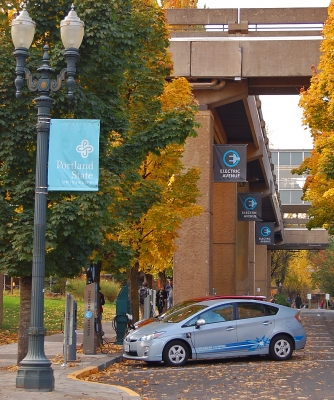Research explores impacts of electric vehicle charging

With the emergence of electric vehicles (EVs) as an environmentally friendly alternative to the internal combustion engine, OTREC researcher Robert Bass decided to investigate some of the uncharted effects of their growing prevalence.
Bass is interested in measuring and understanding the impacts that electric vehicle charging stations have on their cities’ power distribution systems.
Electric Avenue, located on the Portland State University campus where Bass is an associate professor, is the perfect research opportunity: a row of EV charging stations along Southwest Montgomery Street, between Broadway and Sixth Avenue in downtown Portland, Ore.
Launched in August 2011 as a joint project by Portland General Electric, PSU and the City of Portland, Electric Avenue is intended as a research platform for understanding the impact EVs have within the larger context of the city.
Nonlinear loads such as EV chargers can introduce power quality issues to a city’s electricity distribution system. Bass, with PSU undergraduate student Nicole Zimmerman, set out to measure the power quality effects of EV chargers along Electric Avenue.
Power quality manifests in several ways; for this study, the researchers focused on harmonic currents since these have the potential to affect the lifetime of transformers.
The research was focused on investigating three hypotheses.
The first hypothesis was that, because EV chargers are nonlinear loads and demand a large amount of power, any power quality issues in the charging station could have an impact on distribution assets like transformers.
The second; that the total harmonic distortion of the current would change with time, as the charge controller moved through various phases of the charging cycle.
Thirdly, researchers hypothesized that the cumulative effects of multiple charge controllers on the same feeder would result in distortion greater than that of any single controller; meaning that there would have to be a limit on the maximum number of EV charging stations that should be connected to a single feeder.
The team gathered and analyzed two data sets.
The first set of data came from a week-long survey of usage at Electric Avenue that was collected by students from OTREC, under the direction of John MacArthur, in 2012. The second set of data was collected by a power quality engineer from Portland General Electric from October 22-29, 2012.
After data analysis, they noted that power quality issues in the charging station could indeed have an impact on overall distribution: charge controllers at times demonstrated relatively high levels of total harmonic distortion, which is associated with adverse impacts on distribution assets.
Also as hypothesized, they found that total harmonic distortion does vary during the course of a charge cycle, starting out low and tapering upwards toward the end of the cycle.
With respect to the third hypothesis, researchers calculated the cumulative effects that concurrent operation of multiple charge controllers have on total demand distortion.
The study results indicate that Electric Avenue is a robustly designed EV charging system, with very low total demand distortion. This research was not aimed at discovering problems with the design at Electric Avenue, but rather at using Electric Avenue as a test bed for understanding how EV chargers can impact power quality if design constraints are not properly considered.
To build upon this research, Bass’s future goals include developing nonlinear models of various EV charge controllers in a simulation environment, to predict possible effects on distribution hardware and to help manage system upgrades as needed.
He will also explore costs and techniques for some potential improvements to the existing Electric Avenue metering structure, to improve sample rate and resolution for future projects of this nature.
For more information about this project, click here to visit the project page or download the final report.
